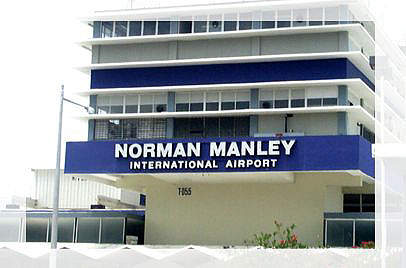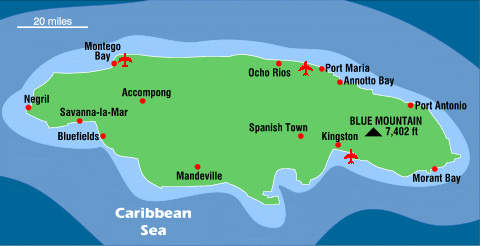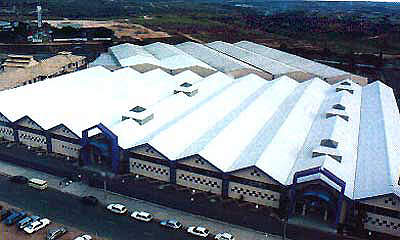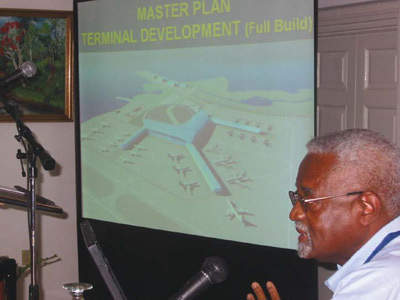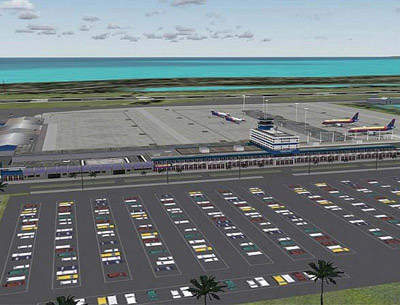Kingston’s Norman Manley International Airport (KIN) is the major gateway linking Jamaica’s capital city to destinations worldwide. It is located on 228ha of the Palisadoes peninsula in south-east Jamaica, in close proximity to the historical site of Port Royal, and is approximately 30 minutes away from the main business district of New Kingston.
Because of its convenient position the airport is a major business passenger carrier and is also responsible for a major portion of the aircargo entering Jamaica from abroad. Norman Manley International Airports Limited (NMIAL), the operator, manages and controls the operations of the airport under a licence from the Jamaica Civil Aviation Authority (JAA). The airport is expected to handle 1.9 million passengers by 2013 and 2.5m by 2022.
Redevelopment 1999–2003
The airport has undergone several refurbishment projects since 1999, including the resurfacing of the runway (2.8km) in 2001, the reconstruction of the eight taxiways (40ac) in 2002 and the replacement of the airport apron and also the replacement of the underground fuel hydrant system (1999).
In addition the airfield lighting system was refurbished. Landside improvements at the airport have included the upgrading and rehabilitation of the national air traffic control and navigational equipment at four of the sites operated by the Jamaica Civil Aviation Authority across the island; and also the installation of a new sewage treatment plant and incinerator to enhance solid waste disposal. All these projects cost $59m and were completed by 2003.
Terminal building
As part of the 1999 to 2003 refurbishment project substantial upgrading of the terminal building and associated facilities were carried out.
Improvements were made to the customs hall in the form of a new 70t air-handling unit, along with associated ductwork and housing. In addition there was an extension and renovation of the existing departure / transit lounge; upgrading of the departure / ticketing concourse (550m²); reconfiguration of the customs exit and ground transportation arcade; construction of remote parking facilities; and redesign and expansion of existing roads, car park and landscaped areas surrounding the terminal.
As part of the project a cargo village (phase 1) was also built to improve cargo operations. This took the form of a 30,000ft² facility with associated electrical, mechanical and car park facilities and was delivered by the end of 2005.
In 1999 The Airports Authority of Jamaica engaged the joint venture of EDM-Cansult to design and upgrade the facilities of the airport.
The project was financed by the Inter-American Development Bank (IADB) and the Government of Japan.
Redevelopment 2003–2006
The Airports Authority of Jamaica is now in the midst of a new project to rehabilitate the airport terminal at Norman Manley (as an arrival terminal) and also to build a new departure terminal (with a winged design).
The project consists of the design, construction and commissioning of a new passenger departure terminal and an upgraded arrival terminal, with supporting airside and landside infrastructure. It includes consulting engineering and architectural services and project management.
Terminal renovation
The contract relating to additions and alterations to the departure concourse was awarded to Cooper and Associates and was valued at $161.5m. The contract, which included construction of a new canopy, construction of an additional drop-off pavement area and provision for access by wheelchair passengers, new elevators, electrical air conditioning, public address, fire detection and fire fighting services, has been completed. The company has also made alterations to the existing check-in concourse and mezzanine level to include a new security post and postal agency.
The architect / engineer for the designs were Harold Morrison and Associates in conjunction with Peter Jervis and Associates and Grace Ashley and Associates.
New terminal master plan
The project seeks to increase the airport’s capacity to cater for projected air and passenger traffic to 2033. The project is part of a master plan that will be implemented in three phases (1A, 1B and 2) and will cost about $130m. By 2022 it will have involved a virtual reconstruction of the entire airport.
Construction started in June 2006. The first phase, which is supposed to make the airport an IATA category C airport, was intended to be completed by 2007 in time for the Cricket World Cup 2007. However, it opened in June 2008.
The European Investment Bank is providing $40m and the Caribbean Development Bank has approved a loan of $11m (June 2006) for the new project.
Phase 1A
Phase 1A commenced planning in 2004 (ground-breaking took place in September 2006). It was completed substantially and launched for operations in June 2008. This phase included the construction of a new terminal building at the eastern end of the present terminal.
The terminal includes a three-level departures concourse of approximately 170,000ft² (10,000m²). Integrated with the existing ticketing concourse, the concourse comprises 66 airline check-in positions with common user passenger processing system (CUPPS), self-serve check-in kiosks and extended outgoing immigration and security screening stations with space to accommodate explosives detection equipment.
The ground floor contains a departure check-in hall with retail and food facilities. The upper floor has a new departure lounge with retail and food facilities. New terminal facilities also include retail space, baggage handling systems and flight-information systems.
The ticketing area accommodates 54 check-in desks and a common use terminal system will be introduced to support airlines.
Phase I A also saw:
- The upgrade of roadway system and expansion of the public car park
- Major rehabilitation of the existing departures concourse and related underground services infrastructure
- Major rehabilitation and upgrading of the terminal arrivals area, including immigration hall, customs hall, arrivals arcade, arrivals, duty-free shops and offices
- Replacement and upgrading of airport systems – public address, access control, flight information, baggage information, security control and other airport IT systems
- Development of cargo warehouse complex. The first phase of the complex, called the NMIA Cargo and Logistics Centre, has been launched for business
In addition limited renovation works to the existing terminal building, reconfiguration of the customs hall for more efficient passenger movement and creation of the cargo village to facilitate improved cargo handling operations were also undertaken (first phase completed in 2005).
Auto Solutions has been awarded the contract, valued at $41.2m, for the repair and service of airport vehicles.
Phase IA also includes the construction of an arrivals concourse, which is currently in progress. Work includes extension of the immigration hall and support facilities and the construction of additional retail facilities and covered walkways equipped with seating, lighting and outdoor furniture.
Contractors
Boyken International provided cost management services during the programming, planning and design phases. Sypher Mueller International is the planning consultant for the new airport and Llewelyn-Davies Joint Venture is the architect.
Kier Construction, part of the Kier Group, has secured the £28.8m contract to construct the new terminal building.
The Kier contract also involves the construction of a new two-level passenger finger (pier) that separates arriving and departing passengers, as required by security regulations.
Phase 1B
Phase 1B is scheduled for the period 2010–2012 and will cost approximately $23m. Works under this phase will include construction of a new arrivals area, relocation of the General Aviation Centre and installation of new baggage handling facilities.
Existing buildings will be upgraded and expansion of aircraft parking stands and taxiways has also been planned. The runway will be extended by another 300m. Engineering and design proposals for the runway expansion will be issued by the Airports Authority of Jamaica.
Phase 2
Phase 2, which is the final phase of the project, is to commence in 2013 and end in 2022. This phase will involve additional improvement and maintenance works to the terminal, landside, airfield and support areas of the facility at a cost of $9m.

